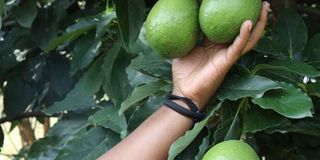Grafting tree makes the deal even sweeter

PHOTO | JEFF ANGOTE
What you need to know:
- Grafted avocados, experts say, have several advantages over normal planting
Colloquially referred to as the alligator pear because of its shape and the leather-like appearance of the fruit’s skin, its nutrition concentration is in the dark green flesh that lies just beneath the skin.
The crust is best reached by employing nick and peel method where you cut it into two halves and twist them in opposite direction, separating them in the process.
After this, cut the half lengthwise to produce a long quartered section. Hold the section in your left hand then using your right hand thumb and index finger to grip the sharp edge of the skin and peel it off.
Now, grafted avocados, experts say, have several advantages over normal planting.
Mr Emos Kibiwot Ego, a plant breeding expert and a PhD student at University of Eldoret, says grafted avocados mature in five to six years as opposed to eight years in normal planting.
“Harvesting can start in as early as three years,” he says.
They are also high-yielding and disease-resistant.
SCIONS
To graft avocados, farmers buy scions of the exotic variety, which are highly proliferative and stumps of local variety reputed for superior rooting.
Grafting is a breeding technique where you attach the top of one plant (scion—selected from stem, leaves, or fruit) onto the rootstock of another plant.
It works with compatible (same species) plants. For a successful grafting to take place, vascular cambium tissues of the stock and scion plants must be in contact with each other by a special tape to bind them.
Tar paint is then applied to protect the cut ends. Both tissues must be kept alive until the graft completely occurs.




